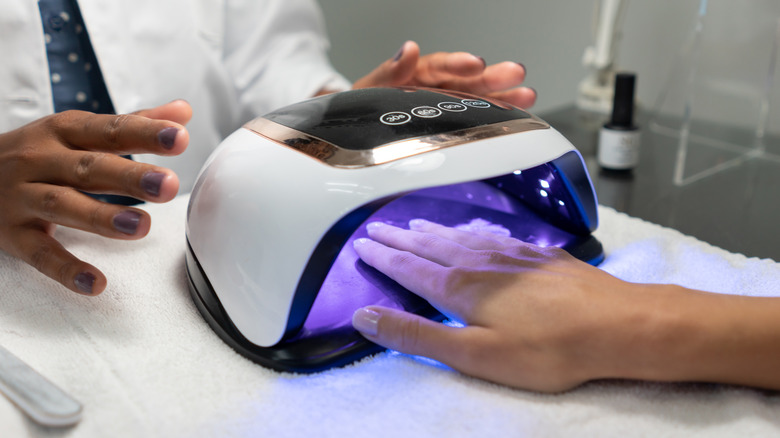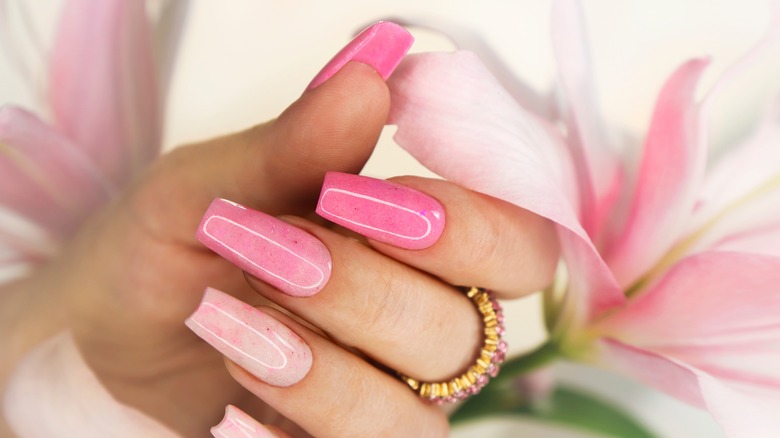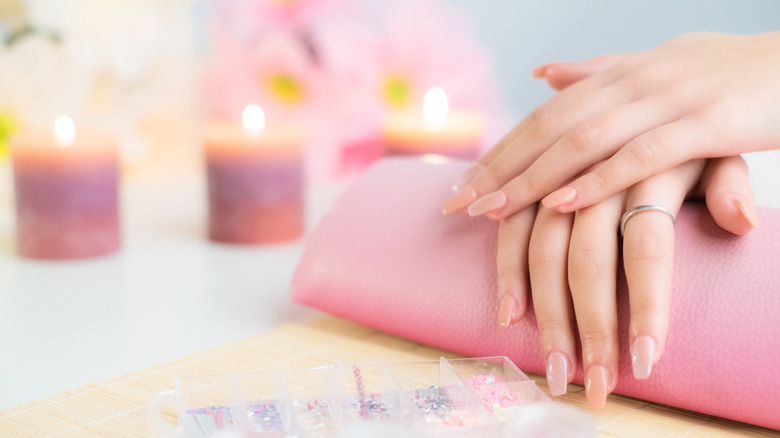Can You Be Allergic To Gel Nails? The Risks To Be Aware Of
Who doesn't love trying a swoon-worthy nail trend? From eyeshadow nails and bubble gloss nails to moody French moon nails, there is plenty of gel nailspiration making the rounds. As with anything in life, though, too much of a good thing should be avoided.
A 2023 study published in Nature suggested that the ultraviolet (UV) lamps that are used to set gel polishes emit radiation that may lead "to cancer-causing mutations in human cells." These findings were further strengthened with a warning issued by the British Association of Dermatologists (BAD) linking artificial nails to a number of allergic reactions. The organization first issued a warning about the use of gel nail polish in 2018 after seeing numerous reports of allergic skin reactions due to the presence of methacrylate chemicals in these products. It recently reiterated its concerns in light of more people choosing to invest in at-home gel manicure kits, which are considered far more dangerous than treatments done by professionals.
What kind of allergic reactions can you have to gel nails?
The main component in gel nails is methyl acrylate, which is an acrylic compound that may cause skin irritation or contact dermatitis, New York-based board-certified dermatologist Hadley King told Allure. She describes the allergy in this case as typically being a "red, itchy, bumpy, uncomfortable rash." However, gel nail polish also contains other potential allergens, such as nitrocellulose, tosylamide formaldehyde, camphor, dibutyl phthalate, and dyes.
Though one might assume that the allergy manifests around the nails, it can occur anywhere the gel nail polish comes in contact with the skin. Purvi Parikh, an allergist and immunologist with the Allergy & Asthma Network, told Allure that allergy symptoms may arise on "the eyelids, chin, side of face, and neck," which are areas we frequently touch but never notice.
The biggest risk of allergies with gel nails is that people do not associate these kinds of symptoms with the correct cause, which can lead to other potential dangers. "It is important that they get a diagnosis so that they can avoid the allergen but also because developing an allergy to these chemicals can have lifelong consequences for dental treatments and surgeries where devices containing these allergens are in common use," Dr. David Orton of the British Association of Dermatologists told BBC.
Other risks to be aware of with gel nails
The best way to deal with potential allergies to gel nails is by arming yourself with knowledge. Dr. Sonia Khorana, a general practitioner with a special interest in dermatology, shares the following potential symptoms to look out for when speaking to Grazia. If your lips are swollen, there is a prominent and angry rash on any part of your body that isn't linked to the use of another product, or your eyes are watering and itchy, it may be an allergic reaction. As for the nails, you may develop small bumps and blisters around them, or you may see discoloration or peeling. Your cuticles may also look redder or more swollen and feel hotter than usual.
If you are witnessing these symptoms, the first thing to do is avoid the use of home kits for gel nails. You should also visit an allergist for a patch test to determine the underlying cause. Changing your polish may also help — look out for nail polish brands that have eliminated methyl acrylate and other potential irritants from their list of ingredients. If nothing else seems to work, just remember the advice of this nail artist who believes there is no harm in pressing pause on the polish every now and then — your nails will thank you for it.


